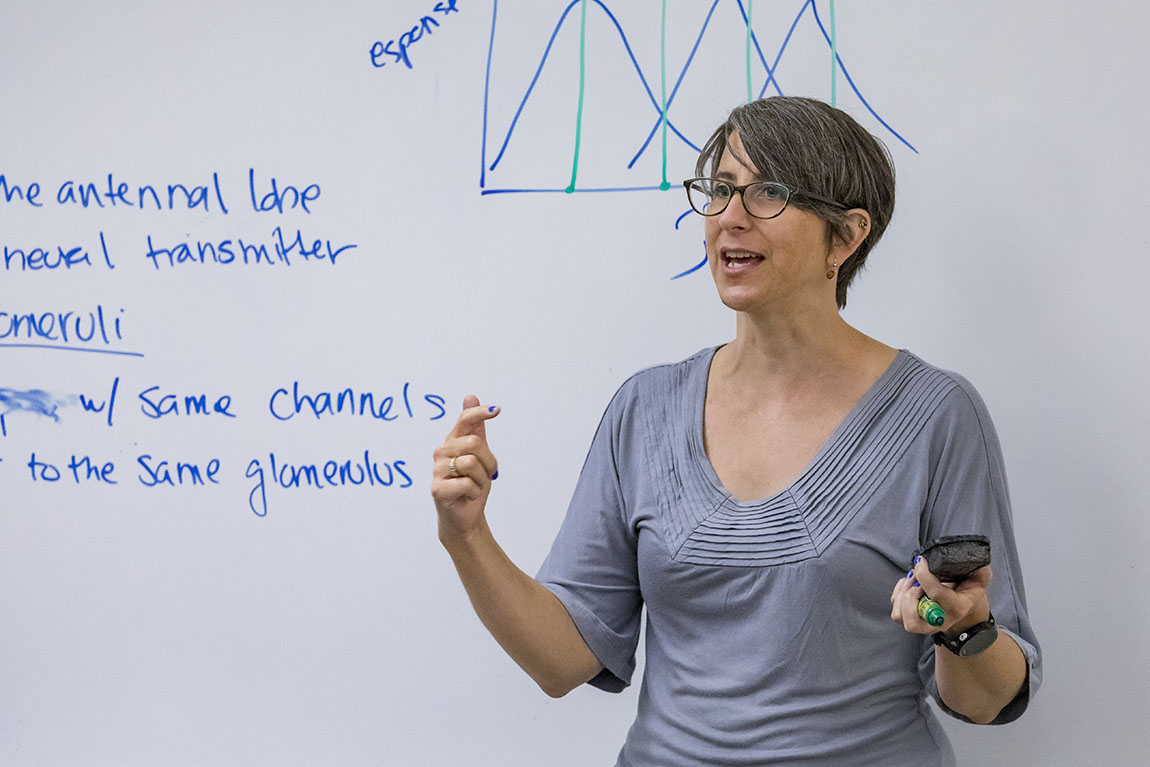Why I Study…the Effects of Odor Pollution on Bumblebees
Associate Professor of Biology and Neuroscience Jordanna Sprayberry shares how she came to her current field of research.By: Jordanna Sprayberry, as told to Meghan Kita Friday, September 20, 2019 11:43 AM
 Associate Professor of Biology and Neuroscience Jordanna Sprayberry teaching at Muhlenberg's Brain Camp in 2018.
Associate Professor of Biology and Neuroscience Jordanna Sprayberry teaching at Muhlenberg's Brain Camp in 2018.I can’t remember a time when I didn’t want to work with animals; my first word was “geese.” I hoped to study animals, maybe as a marine biologist or wildlife veterinarian, but by the time I finished college, I had discarded notions of working in conservation hotspots. I had studied abroad in Africa, where I realized what I’d previously learned about conservation problems was American-centric and embodied an enormous amount of economic and racial privilege. For example, I had grown up with this narrative of, “Stop deforesting the rainforest.” If you actually go to the rainforest, why are people cutting down trees? To grow products that Americans buy.
I thought about going back for a degree in engineering and going into alternative energy development, but I really love animals. Ultimately, I was like, “This is what I’m best at and this is what I enjoy the most.” I felt liberated to go to graduate school to follow my passion. I looked at labs studying all kinds of animal behavior, including people working on octopus mating, squirrel territoriality and hyena social structures. I also talked to a honeybee guy and an insect vision physiologist. The two bug guys were just really relaxed, collaborative and welcoming.
For my Ph.D., I studied how hawkmoths respond to flower motion signals. For the behavioral portion of my thesis, I spent eight months getting essentially two weeks of data. If you watch hawkmoths in the wild, they are talented and graceful. In the lab, you’re dealing with the descendents of animals that were brought into a domesticated situation 50 years ago. They have become corpulent and non-responsive. In my postdoc, I ran more than 110 trials in my first year and I got exactly one animal to feed.
So, I got frustrated because I wasn’t able to gather the data I wanted on innate feeding preferences. I also had been working to transition towards aligning my conservation interests with my research interests, and I got really interested in this idea of sensory pollution. We often think about human impacts in terms of their direct effects: What kind of animals are killed by the toxins we put in the water? But we don’t necessarily think about the fact that we are modifying the entire sensory landscape that animals live in. I knew scientists who worked with bumblebees, and I started working on a collaborative project to learn how to handle them. When I got to Muhlenberg, I started a project on the effects of odor pollution on bumblebees.
Our first publication was on the effect of the odors of fungicide and turf builder, an herbicide-fertilizer mixture, on bumblebee foraging patterns. Then, we went back to think about how much you have to change an odor to get a bumblebee to change its behavior. We have crafted a mathematical method of representing complex odor blends, and we’ve been using behavioral techniques to determine whether that math is a reasonable approximation of how bees are perceiving odors. It looks like it is. It might be a useful tool to say, “Is this particular odor going to change this floral scent to something that confuses a bee?” It looks like we’ve accurately identified a zone of confusion.
The type of odor pollution that we’ve been looking at may reduce nectar acquisition. For bumblebees in particular, they will only successfully produce queens if their colonies have a whole heck of a lot of resources. So it’s only the biggest, most productive, most successful colonies that succeed in making queens by the end of the summer, and those that don’t will die out. If our results are relevant to how bumblebees behave in “the wild,” understanding odor pollution certainly would be relevant in terms of conservation efforts. One of the upcoming projects in the lab will start to look at just how important odor pollution is in the field.
